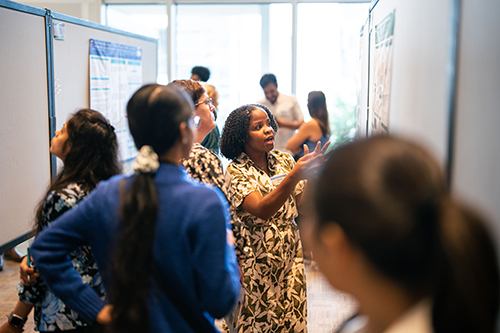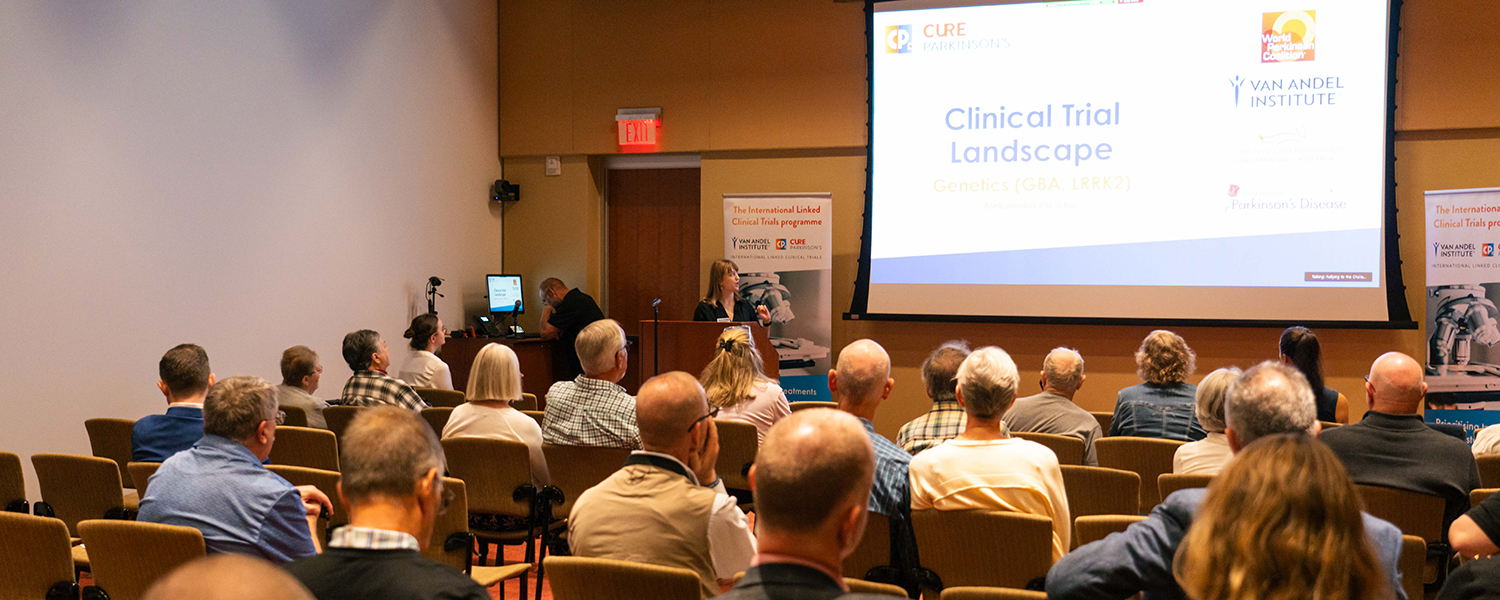In September, Van Andel Institute welcomed nearly 300 scientists, physicians and people with Parkinson’s for our annual Grand Challenges in Parkinson’s Disease symposium and Rallying to the Challenge meeting.
This year’s program focused on the potential of cell-based treatments as new, much needed ways to slow or stop Parkinson’s progression.
Missed the events? Not to worry. Here are three big takeaways:
Cell-based therapies hold promise as potential treatments for Parkinson’s
Cell-based therapies aim to protect or replace cells that produce dopamine, an important chemical in the brain that plays several vital roles, including helping to enable movement. Loss of dopamine-producing cells causes many of Parkinson’s hallmark movement-related symptoms.
Scientists are exploring many different options for cell-based therapies. One such strategy discussed during the symposium is the use of induced pluripotent stem cells (iPSCs). This technique may allow scientists to modify a person’s own cells to potentially replace lost cells in the brain.
Here’s how it works: Scientists receive cells from a person’s skin or blood. Once collected, scientists reprogram these cells into iPSCs, which are then coaxed to become new healthy dopamine cells. These healthy cells then could be transplanted back into the individual from whom they were collected. Although still experimental, this approach may one day offer new hope for treatment. In the meantime, scientists are using iPSCs to study the underlying mechanisms of Parkinson’s at a cellular level, test potential treatments and explore the different types of cell replacement therapies.
Presenters at the symposium also discussed some of the biological considerations necessary for cell-based therapies to work.
- Solving a sticky problem: In Parkinson’s, alpha-synuclein proteins become misshapen and stick together. The resulting clumps are called Lewy bodies, which are thought to damage and contribute to the loss of dopamine-producing cells. Medications that break-up or prevent the formation of Lewy bodies may hold promise as potential Parkinson’s treatments.
- Identifying why some cells are vulnerable: Understanding why some cells seem to be more vulnerable to Parkinson’s while others are more resilient may help scientists protect susceptible cells. Doing so may pave the way for better treatment strategies.
- Understanding genetic risk: To date, scientists have identified several Parkinson’s-related genes, such as LRRK2 and GBA1. Mutations in these genes affect their function and can contribute to Parkinson’s development. Understanding the role of genetics can help scientists develop more precise, tailored cell-based therapies.
Improving the lumbar puncture process for people with Parkinson’s
During Rallying to the Challenge, our annual meeting for people with Parkinson’s co-hosted with Cure Parkinson’s , participants had a lively discussion about lumbar punctures.
This medical procedure involves inserting a needle into the lower back to extract a sample of cerebrospinal fluid (CSF). CSF samples help scientists study Parkinson’s and track disease progression in clinical trials. However, lumbar punctures are notorious for being uncomfortable to sit through. One of the goals of this year’s Rallying to the Challenge meeting was to gather feedback from participants on how to improve the lumbar puncture procedure.
Although everyone shared unique experiences, all participants underscored the need for clear information prior to the procedure.
Many people felt they were not adequately prepared for what to expect during a lumbar puncture procedure and didn’t receive sufficient information on necessary follow-up steps.
Specifically, Rallying participants advised that this better information up front could boost clinical trial participation, which is critical for evaluation of new medications.
Rallying representatives then presented their findings to the scientific audience at Grand Challenges in Parkinson’s Disease, which serves as an important bridge between the advocate and research communities.
Collaboration is the path to progress

Grand Challenges in Parkinson’s Disease and Rallying to the Challenge offer a space for scientists, physicians, care partners, people with Parkinson’s and advocates to tackle the next big challenges together. Importantly, these events provide an opportunity to share the latest innovations, ensuring everyone is on the same page.
It also showcases the power of collaboration. A prime example of this is the International Linked Clinical Trials (iLCT) program, which is spearheaded by Cure Parkinson’s together with VAI. Following Grand Challenges in Parkinson’s Disease, VAI hosted the annual iLCT meeting, which brought together leading Parkinson’s experts from around the world. Each year, the iLCT Committee examines dozens of potential therapeutics and selects those that have the highest likelihood of successfully treating Parkinson’s. These candidate medications are then prioritized for evaluation in clinical trials. Read more about this exciting initiative here.
To stay up to date on next year’s Grand Challenges in Parkinson’s Disease symposium and Rallying to the Challenge meeting, please visit grandchallengesinpd.org.
Grand Challenges in Parkinson’s Disease and Rallying to the Challenge honor excellence
VAI presented the Jay Van Andel Award for Outstanding Achievement in Parkinson’s Disease Research to Anders Björklund, M.D., Ph.D. This award is given to scientists who have made outstanding contributions to Parkinson’s disease research and who have positively impacted human health. Björklund was recognized for his pioneering efforts to find ways to prevent and repair cellular damage caused by the disease.
VAI and honored Professor Oliver Bandmann with the Tom Isaacs Award. This award recognizes a researcher who has significantly impacted the lives of people living with Parkinson’s and has involved them in their research. Bandmann is widely known for his efforts to find new treatments to slow, stop or reverse Parkinson’s, as well as his immense involvement in working with people with Parkinson’s to improve care.
